Pairing a 1999 Porsche 911 GT3 996.1 vs 2024 911 GT3 Touring 992.1
Continuing our look a the 911’s sixty-year evolution, we evaluate bookends of the hugely popular GT3 line, pairing an early 996 GT3 with a new 992 GT3 Touring...
Words Mark Smyth, Dan Furr and Johnny Tipler
Photography Dan Sherwood
POWER OF THREE
LEGENDARY MODERN CLASSIC
FRESH APPRAISAL OF THE 996 GT3 — WHY NOW IS THE TIME TO BUY THIS 911 HERO

Let’s take a moment to consider the 1973 Carrera RS 2.7 Touring. This motorsport-derived 911 was popular, not just because of its performance, but because it defined what a touring car should be: great on a track, but enabling you to drive cross-continent, before climbing out in a posh outfit for a fancy dinner. In decades to come — assuming, of course, we’re still allowed to marvel at great GT cars with internal combustion engines — will we look at the 992 GT3 Touring in the same way? We suspect the answer is in the affirmative because, if you’ll excuse the overused clichés, this 911 is a wolf in sheep’s clothing, an iron fist in a velvet glove. A GT3 in a tailored suit.

Editor Furr was recently handed the keys to the brand-new 992 GT3 Touring you see on these pages. Finished in gorgeous Gentian Blue Metallic (an £876 cost option) over two-tone leather (add a whopping £6,683) and featuring bucket seats (£3,788), a front axle lift system (£2,214), Sport Chrono (£194), brake calipers painted gloss black (£581), tinted LED headlights with Porsche Dynamic Light System Plus (£876, matching the cost of the paintwork) and BOSE audio equipment (£1,002), this 199mph rocket ship’s total price rolls in at £154,401, a fair hike over the GT3 Touring’s starting point of £135,700. The difference is enough to buy you a 996 Carrera 4S. Before we get carried away, however, let’s talk about what the Touring is and what it is not. Regarding the latter, what it isn’t is a 911 with looks suggesting pit stops, rather than coffee stops. We’re big fans of the traditional big-winged GT3, but there’s something about the Touring that’s understated, perhaps introverted (if a 911 can ever be introverted?!).
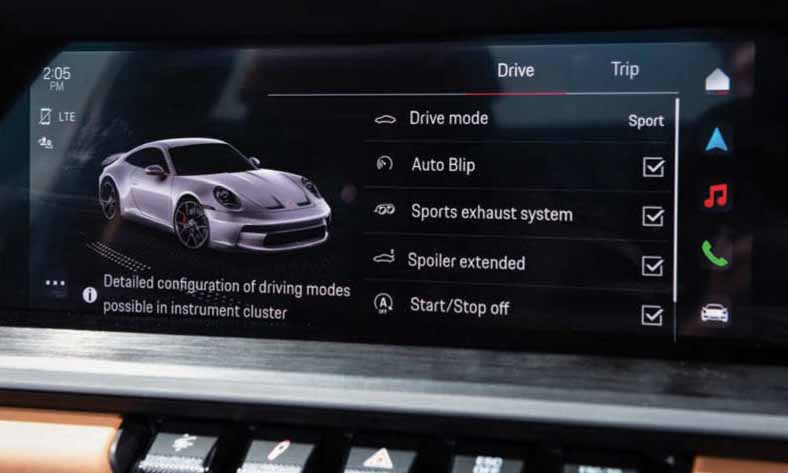
Instead of the massive rear appendage, the Touring wears a discreet, extendable spoiler sitting close to the give-away GT3 Touring badge on the unique rear grille. There are a few other subtle design touches aficionados will spot, such as the light silver Porsche lettering across the rear and window surrounds finished in anodised aluminium, but all eyes will be (or not, as it were) the back end. That said, buyers may wish to option their GT3 Touring with a carbon-fibre reinforced plastic (CFRP) roof, black detailing and Satin Darksilver wheels, all of which are attention grabbing. There are also a number of other tell-tale signs this is a special 911 — a unique front bumper with integrated ducts positioned close to the base of the CFRP bonnet is a giveaway, as is wider track front and rear. It all looks sporty, but sophisticated, like a world-class athlete in a sharp suit at the Laureus Awards.
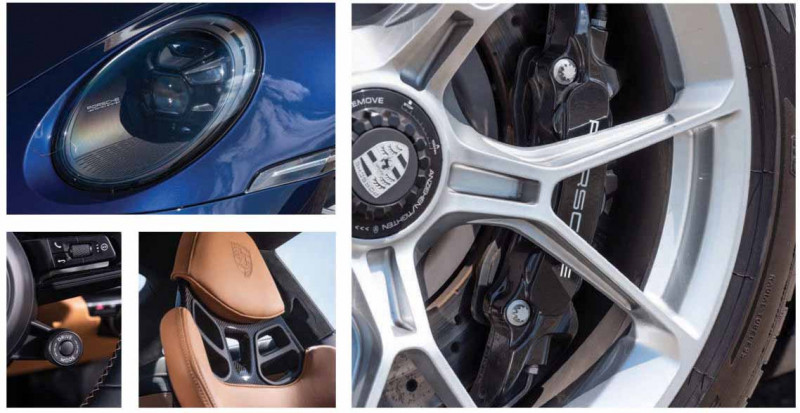
Inside, rather than the sporty Race-Tex upholstery of the winged model, leather is used for the seats, steering wheel, gear lever and centre console armrest. Race- Tex is, however, used for the roof lining. There are touches of brushed black aluminium and, while the GT3 Touring doesn’t include rear seats as standard equipment, at least there’s a bit more space, especially when compared to new GT3s fitted with the optional Clubsport roll cage. There is, naturally, a whizzy Porsche Communication Management infotainment system, although Dan tells us he wasn’t really interested in listening to his favourite Napalm Death tunes when behind the wheel. Instead, the generously sized touchscreen was used to configure chassis settings. Digital screens are located either side of the rev counter, and although these aren’t exclusive to new GT3 models, they’re a joy to use.
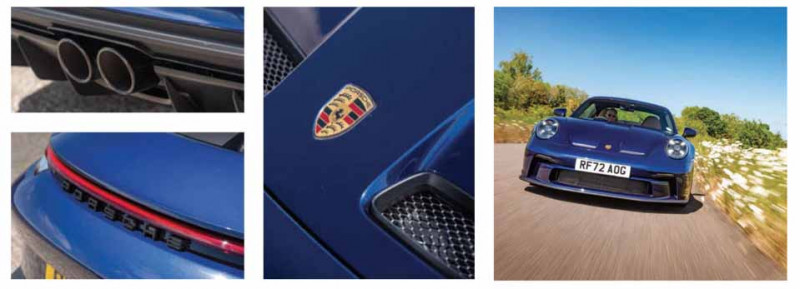
We especially like the ability to reduce the information displayed at the touch of a button. Essentially, you can extinguish all potentially distracting display information, save for essentials, such as fuel level, tyre pressures and oil temperature. Ideal for track time. On this note, it’s important for us to state the GT3 Touring is sporty, but not in a ‘race car’ kind of way. It’s sporty of the kind prospective GT3 Touring purchasers understand — they want GT3 levels of performance, but they don’t want to compromise comfort.
This is easier said than done with racebred sports cars, but in case of the 992 GT3 Touring, you really do get a superb blend of power and comfort. Best of all, this fine balance is achieved in a 911 capable of being remarkably discreet when you want it to be.
WISH YOU WERE HERE
Beneath the sharp-suited exterior is the GT3 Touring’s alternate personality, born from motorsport. Like the winged GT3, the Touring features the same double-wishbone front suspension put to use in Porsche’s RSR race cars. Additionally, the engine is based on the flat-six used to great effect in the 911 GT3 R endurance racer. It’s a four-litre, six-cylinder boxer producing 503bhp at 8,400rpm and peak torque of 346lb-ft at 6,100rpm.
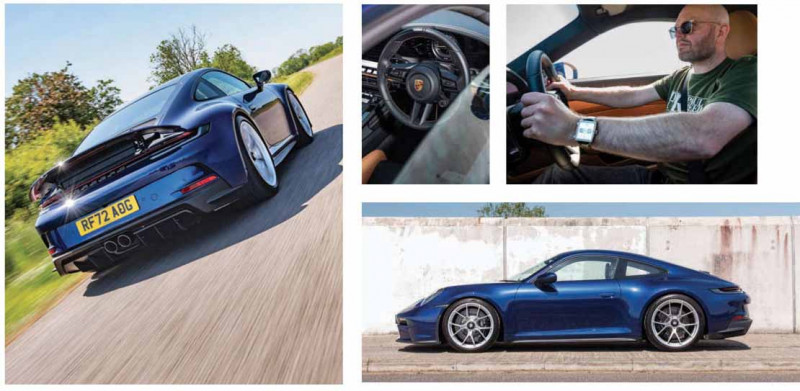
The redline is an impressive 9,000rpm before the needle bounces off the limiter, although that’s unlikely to happen in a GT3 Touring loaded with a seven-speed dual-clutch PDK gearbox. As our test car proves, manual transmission is available.
The price is the same regardless of the type of cog swapper you choose. Porsche people are nice like that. On the outside, the GT3 Touring looks friendly enough, but hit a great piece of road and you’ll quickly discover it’s a machine needing you to keep your wits about you. This car requires mastering in a way that’s on the one hand immensely rewarding, but on the other, extremely involving. Yes, this 911 can cruise comfortably without a care in the world, but if you want to make the most of the performance and the exemplary engineering available, then you have to be willing to take control.
Thinking back, our time with the big-winged GT3 took place on a rather damp day at Anglesey Circuit. In stark contrast, we took to Oxfordshire’s rural back roads in the GT3 Touring on a beautifully dry day. It was immediately apparent how the Touring is just as capable as any GT3 before it, irrespective of creature comforts. Logically, it’s more capable — dab the accelerator and the engine responds instantly, while the steering is as precise as you can get in any sports car currently on sale.
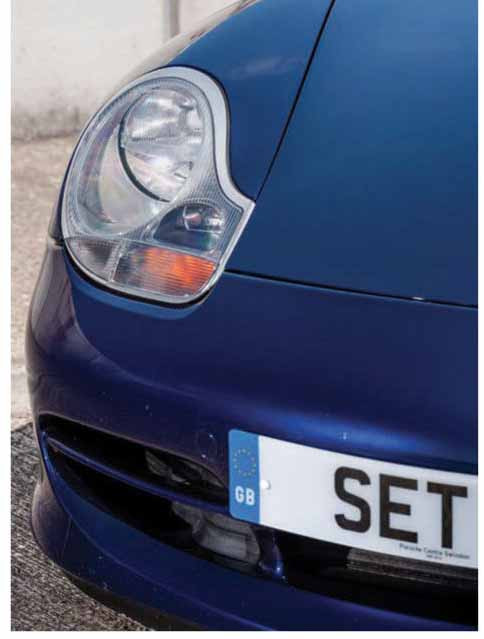
We pulled away from where we collected this powerful Porsche and, within minutes, we felt like we were in familiar territory — it took just moments to find the correct driving position, something not so easy in the GT3, complete with its Clubsport bucket seats and the need to make use of an Allen key to adjust backrests.
The GT3 Touring’s controls are all well within reach and, pleasingly, pulling up the settings menu on the infotainment screen allows for quick changes to suspension and sound, the latter courtesy of the active sports exhaust. Our first impression on a relatively sedate drive through the countryside was to consider the GT3 Touring a comfortable tourer (surprise, surprise), capable of devouring miles with ease and without the likelihood of a trip to a chiropractor thereafter. It’s easy to relax in the GT3 Touring, to open the window and savour the sound emanating from the boxer engine behind you. When we hit back roads, however, it was time to pump up the volume. There’s a whole orchestra at play here and, yes, we know that’s another dreadful cliché, but the sound is extraordinary. Meanwhile, the super-sticky tyres feel as though they’re communicating with the road, then sending a message through the steering to the driver without any hint of distortion to the message itself. You can act on the given information immediately, pushing further on the throttle, adding a few more degrees to the turn of the wheel or clamping down on the brakes. The steering requires constant input, but this feels less like a driving chore and more like you’re actually in a conversation with the car and the road beneath. Sublime.
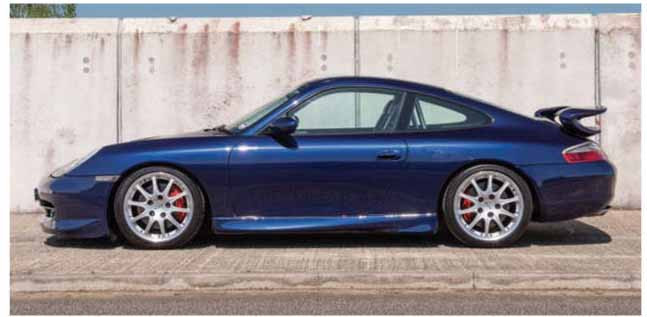
This immersion in the driving experience can be enjoyed with Normal mode active, but dial into Sport and everything sharpens up. If PDK is present, controlling shifts using the paddles and your involvement increases even more. It’s also good to use the gearstick on a PDK-equipped GT3 Touring, chiefly because it feels like you’re controlling the car from a central point — a form of direct connection with the heart of the beast, where you can choose how the car will behave through the next corner.
The suspension is also impressive, something we couldn’t really appreciate during our earlier drive of the winged model on a smooth race circuit in north Wales. Bumpy B-roads can unsettle many sports cars, but not so the GT3 Touring, even with its rear-wheel-drive layout. The new double wishbones up-front keep everything flat, noticeable when you hit a flaw in the road mid-corner. The Touring barely flinches, allowing you to correct the slightest of oversteer and push on.
DESTINATION EXPLORATION
And push on we did, because while we’d been handed a recommended route, it became apparent there were many more great roads for us to enjoy in this neck of the woods. Who were we to deprive the GT3 Touring of them?! We reached a T-junction and tossed a coin: left or right? Left won over, leading us along more winding roads, through areas of woodland and past open fields. We were touring. Eventually (reluctantly), we turned around, but the great thing about driving along fantastic roads and having to make your way back is the fact you get to drive them all over again.
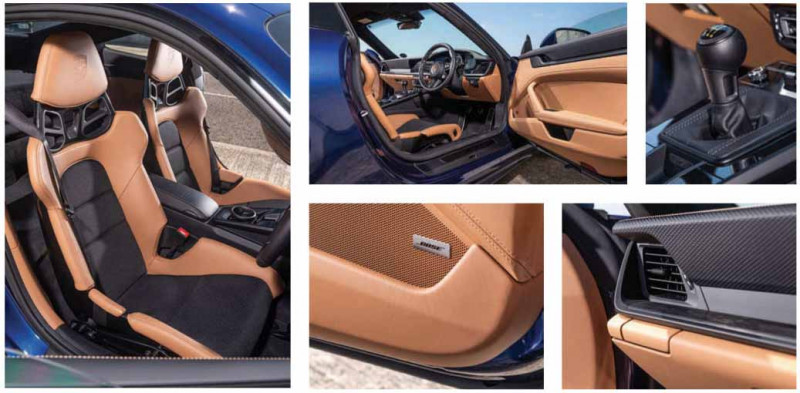
If, at this point in our story, you’re thinking the 992 GT3 Touring is all you could ever want from a 911, then you’re probably right. It doesn’t attract attention to itself, instead looking smart and well-groomed. We’re not about to go all GQ on you, but the GT3 Touring does a brilliant job at looking good in any situation, and that’s only part of the story. When you get the chance to make the most of every element Porsche’s engineers have so perfectly integrated into this 911’s character, you quickly appreciate how the GT3 Touring is more than just a stealthy sports car — as the world moves towards automotive electrification, automation and possibly even legislation making the thrill of the drive increasingly harder to attain, the GT3 Touring is the perfect antidote. It’s a sports car which can be docile or, when you want it to be, demanding. Make no mistake, this is by far one of the most rewarding cars we have ever driven, 911 or otherwise.
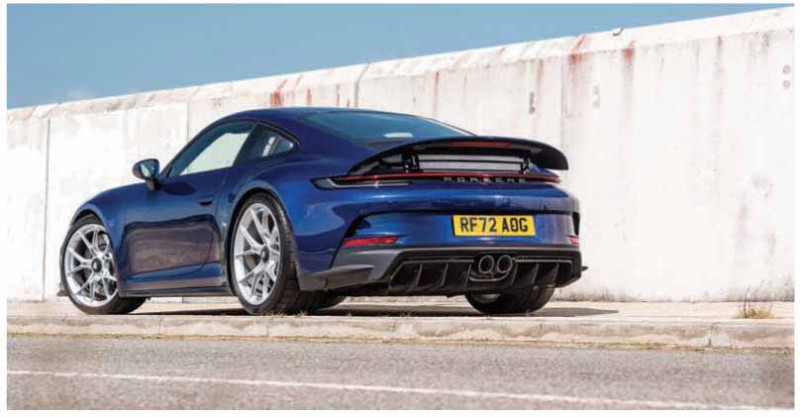
Of course, every era of 911 production has included a rarefied top-line model, usually descended from a race car and, sometimes, badged as an RS. For the first couple years of its life, the brave new water-cooled 996 lacked such a standard bearer, but this was addressed in 1999 with the introduction of the GT3, named after the FIA race category it was eligible for. The GT3 blended a normally aspirated, higher performance engine with a lighter body and sports-tuned suspension, resulting in track-focused demeanour. Hey presto! We had an RS in disguise. Soon enough, somewhat predictably, the GT3 was massaged into a Rennsport in its own right.
The GT3 is the most sublime evolution of the basic 996 model, created using the narrow-body Carrera 4 chassis — in-rear-drive only format — and powered by an unburstable version of the 3.6- litre water-cooled flat-six. There’s no artificial boost and no extraneous ducting about the bodywork, just pure aerodynamic functionality to the splitter, side skirts and biplane rear wing. As much as any other model, the 996 GT3 epitomises Porsche’s design and manufacturing philosophy. A perfect blend of road-going sportscar and track-oriented elaborations, it’s a direct manifestation of a philosophy going back way beyond the much-vaunted 1973 Carrera RS 2.7 to evolutions of the 356, such as the Carrera of 1955.
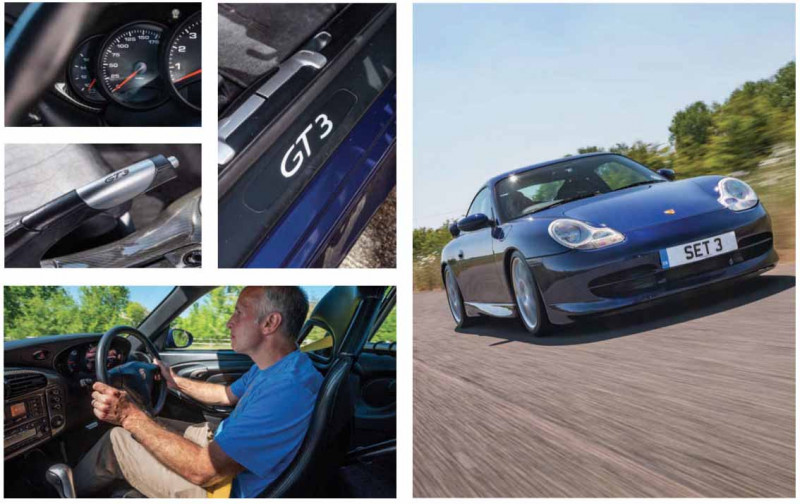
The 996 GT3 was announced at the Geneva Motor Show in April 1999. It certainly looks the part, with its deep front spoiler and airdam, aerodynamically configured sills and fixed double-decker swan neck wing on the engine lid (in first-generation guise) instead of the retractable wing of the then Carrera. The 996 GT3 was immediately seized on as the vehicle of choice for Carrera Cup and Porsche Supercup and, from 2000, the N-GT class of the FIA GT Championship, as well as international races, including the 24 Hours of Nürburgring. The model was an immediate sensation. Manthey Racing’s 996 GT3 R won the GT class at the 1999 24 Hours of Le Mans with drivers Uwe Alzen, Patrick Huisman and Luca Riccitelli at the wheel. Shortly afterwards, Porsche’s tame test driver, Walter Röhrl, took a GT3 around the fourteen-mile Nürburgring Nordschleife in seven minutes and fifty-six seconds, notably under the then crucial eight-minute mark. This was a first for a production car, much to the glee of the Porsche press relations department.
The 996 GT3 is the offspring of Andreas Preuninger, head of Porsche’s GT series production department and manager of Porsche High Performance Cars. A renowned purist, he designed specification to encourage maximum driver involvement. For this reason, automatic transmissions were off the menu. The Carrera 4’s body shell (incorporating front-end stiffening) was adapted to house the GT3’s dry-sump oil tank, different engine mounts and a larger fuel cell. At the time, standard 996 Carreras were powered by a 3.4-litre flat-six, but in order to stand the strains and stresses of on-track use, the GT3 was equipped with a new six-cylinder unit taking the form of the aforementioned 3.6-litre boxer. This engine was based on the crankcase of the 964, allied to a pair of water-cooled cylinder banks and camshafts in a configuration similar to that of the 959, 956/962 and the GT1 Le Mans winner. Heady stuff indeed. This iteration of the so-called ‘Mezger’ engine (named after Porsche engineer, Hans Mezger) was developed free of forced induction to ensure wider race homologation potential. The engine came with a higher 11.7:1 compression ratio, VarioCam timing adjustment and four-valves- per-cylinder. Its plasma-nitrided crankshaft and titanium connecting rods allowed the unit to rev significantly higher than the standard flat-six. The six-speed G96/50 transmission, dual-mass flywheel and forty-percent limited slip differential were sourced from the 993 GT2 and, with 360bhp at 7,200rpm and 273lb-ft torque at 5,000rpm on model launch, the 996 GT3 was the most powerful normally aspirated 911 ever manufactured.
SLICK AS A WHISTLE
The zero-to-60mph rush took 4.7 seconds, while top speed was 187mph. Counting on engine upgrades rather than turbocharging to accomplish higher performance, the GT3 body lacked Turbo or GT2-style vents in its rear wheel arches, enabling a coherent overall neatness of design. There’s handling to match the power and looks, too.
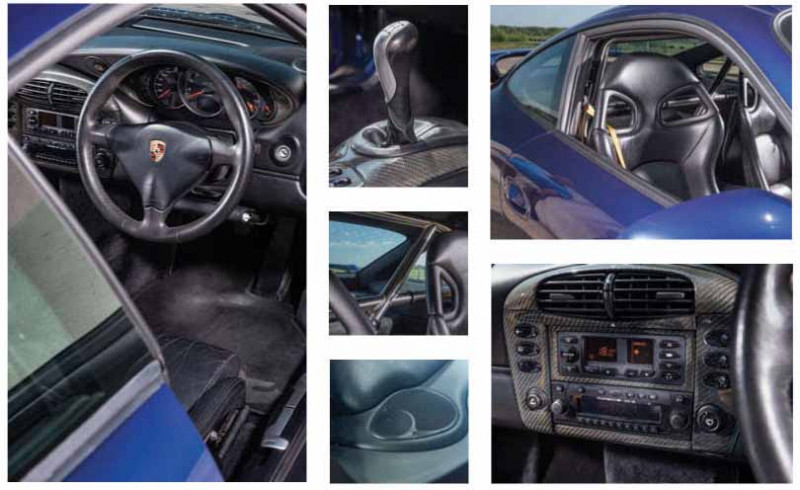
The GT3 sits thirty millimetres lower than standard and its suspension consists of adjustable dampers, shorter, stiffer springs and adjustable anti-roll bars, with cross-drilled and ventilated 330mm disc brakes slotted into redpainted four-piston calipers assisted by ABS 5.3. Porsche inserted five-millimetre spacers for slightly wider track and fitted lightweight ten-spoke Speed Design eighteen-inch rims (eight inches wide at the front, ten at the rear, shod with 225/40 and 285/30 tyres respectively). On the assumption owners would want to take their GT3 on track at some point, two trim levels were offered: Comfort, with lighter sports seats and no rear seats (but otherwise virtually identical to the 996 Carrera), and Club Sport, equipped with a single-mass flywheel (allowing revs to rise and fall more rapidly), race seats and a bolted-inrear roll cage tied in to the rear shock towers for added chassis stiffness. Along with the rear seat delete, side airbags are notable by their absence.
The first-generation 996 GT3 is the last road-going Porsche to be built on the factory’s motorsport production line and is the last Porsche to have a throttle cable. Aside from ABS, there are no other driver aids. Although it’s a heavier car than the standard Carrera, the second-gen 996 GT3 is heavier still, adding a whopping thirty kilos.
DILUTING THE FORMULA
With regard to its ‘second coming’, model buffs reckon the GT3 was somewhat toned down in order to provide more of a contrast with the hardcore 996 GT3 RS. For the first time, however, the GT3 was available in the USA, a market historically wary of hotter evolutions.
Several stylistic changes were evident: the teardrop headlights are sourced from the Turbo (and applied to the rest of the 996 range), replacing the original model’s ‘fried eggs’ and further differentiating the 911 from the Boxster, while the front and rear PU skirts have revised slope angles to the inlets and air ducts, with subtly different curves and splitter. It’s the same at the back panel, which also displays revised contours.
The ten-spoke rims are simplified, side skirts are moulded to enhance aero and the rear wing configured as a platform on a pair of struts (essentially an ‘ironing board’ in place of the earlier GT3’s swanneck biplane). In the performance stakes, power rises to 381bhp with torque up to 284lb-ft (available from 2,000rpm). The later GT3 is also shorter geared in fifth and sixth. The suspension is further lowered and firmed and brakes beefed up with six-pot calipers at the nose (although ceramic brakes were available as a £5,356 optional extra). Bespoke semi-slick Michelin Pilot Sport N1 tyres were developed specifically for the later 996 GT3. In both versions, the spacesaver spare is replaced by a puncture repair kit and inflator.
What we have here is a 1999 car, making it an early first-generation 996 GT3. For a decade, it has been the property of 911 & Porsche World reader, Stuart Tanner, who spent the previous nine years driving a Tiptronic-equipped 993 Targa. That’s quite the contrast. “My 993 was lovely, but a bit dull for a sports car,” he shrugs. “I wanted a more hardcore Porsche. This one was available through Steve Bull Specialist Cars. At the time, independent Porsche mechanic, Christian Sanger, was working at the company as a technician. He has very exacting standards — he told me he knew the car well and vouched for its condition, which is all I needed to hear. To this day, he is tasked with the car’s maintenance.”
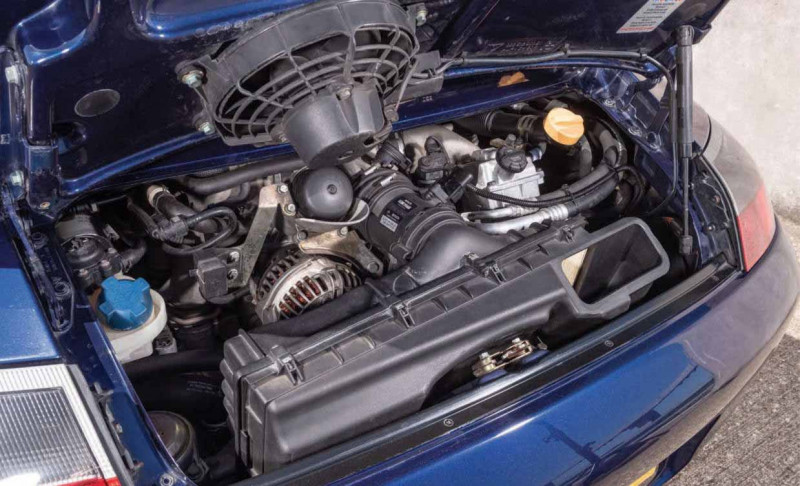
A Comfort-spec GT3, Stuart’s 996 also features a genuine Tequipment roll cage, carbon buckets, carbon dash trim and a centre console manufactured from lightweight weave. When he took ownership, the car had covered just 24,000 miles. The figure now stands at 56,000, a sign of his enthusiasm for using his 911 as Porsche intended. “It was exactly what I was looking for,” he continues, “but jumping from a 993 Targa to a 996 GT3 presented a very different driving experience. I remember being very disappointed. I had romantic ideasof what driving a GT3 would be like, but found myself in a car I thought was a bag of crap. It was only when I used it on track at Castle Combe that I realised how brilliant the 996 GT3 really is. My early impressions of it were formed on the road. I should have realised any track focused sports car will be compromised on the public highway, but take a GT3 to a race circuit and it comes alive. The drive on track was hugely involving. Needless to say, after this revelation, I used the car at as many track days as I could attend, although due to the increased value of early GT3s in recent years, I now split track time between the 996 and a 987 Cayman R.” Even so, SET 3 has been a regular at the Silverstone Classic and has made the trip to Le Mans a few times over the years.
Production of the first iteration of 996 GT3 totalled 1,868 cars, including Comfort and Club Sport variants, significantly less than the 2,300 second-generation GT3s manufactured. Of this volume, Porsche Cars Great Britain imported 103 early GT3s and 246 later cars. More than nine hundred of the second-gen model were exported to the USA. Porsche’s press office tells us the respective numbers of Club Sport and Comfort models were never recorded. Interest in the GT3 line of 911s is reaching new highs, not only on account of the recent run of new models being released into the wild, but also because 2024 will see GT3 cars enter into the World Endurance Championship (including the 24 Hours of Le Mans) for the first time. With many major sports car manufacturers already producing GT3 models, a packed grid is expected in a season marking the 996 GT3’s twenty-fifth anniversary.
A rush of interest in the history of this hugely popular product line is expected, and with it will likely come an increase in the value of early 911 GT3s, which are sure to become regarded as historically significant Porsches. In other words, if you’re in the market for a 996 GT3, don’t delay your purchase. The cost of ownership is very likely to increase across the coming twelve months, especially for low-mileage cars.
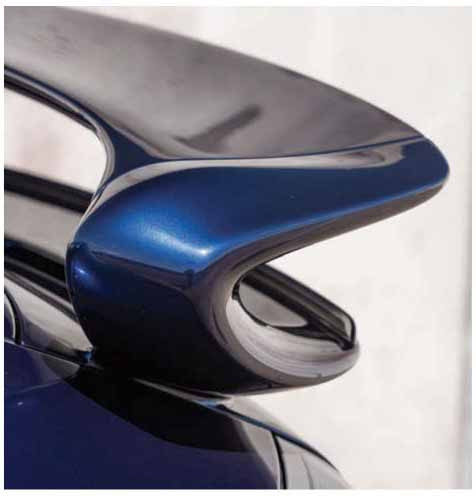
If you are ready to take the plunge, you might be interested in the 996 GT3 buying guide we published in the April 2022 edition of 911 & Porsche World (order a back issue by visiting bit.ly/issues911pw). Highlighting many of the main areas of concern you should be aware of when inspecting an early GT3, the article could spare you a lot of headaches and, importantly, save you a lot of cash. One thing’s for sure: GT3 ownership puts you in command of one of Porsche’s most focused driver’s cars, regardless of whether it’s as old as Stuart’s 996 or as new as the Touring-spec 992 in our pictures. Our advice? If you’re thinking about buying a GT3, don’t leave it until these cars are out of reach.
PORSCHE’S PRESS OFFICE TELLS US THE RESPECTIVE NUMBERS OF CLUB SPORT AND COMFORT MODELS WERE NEVER RECORDED
Above Eggs make a meal out of anything Right With the GT3 category appearing in the World Endurance Championship and at Le Mans next year, interest in these cars will reach new highs.
Above ‘Mezger’ flat-six is a work of art and can trace its DNA back to the giddy heights of Porsche’s motorsport efforts.
Above and below Carbon-fibre was an exotic material at the time of the 996 GT3’s introduction, but Stuart’s early example makes use of plenty of the lightweight composite material.
Above 992 interiors are nothing short of excellent, as this twin-tone leather cost option illustrates.
A DIRECT MANIFESTATION OF A PHILOSOPHY GOING BACK BEYOND THE MUCH-VAUNTED CARRERA RS 2.7 TO EVOLUTIONS OF THE 356
Above and below Chassis configuration is a cinch thanks to PCM’s different driving modes and the ability to override the default settings.
Above Stuart’s early 996 GT3 and this brand-spanking new 992 GT3 Touring are separated by almost a quarter of a century.
Facing page If the big-winged 992 GT3 isn’t civilised enough for you, the Touring Package helps the GT3 keep a low profile, resulting in a powerful 911 capable of cruising in comfort, but also able to unleash a surprise attack at the track.
YOU CAN EXTINGUISH ALL POTENTIALLY DISTRACTING DISPLAY INFORMATION, SAVE FOR ESSENTIALS, SUCH AS FUEL LEVEL AND TYRE PRESSURES


